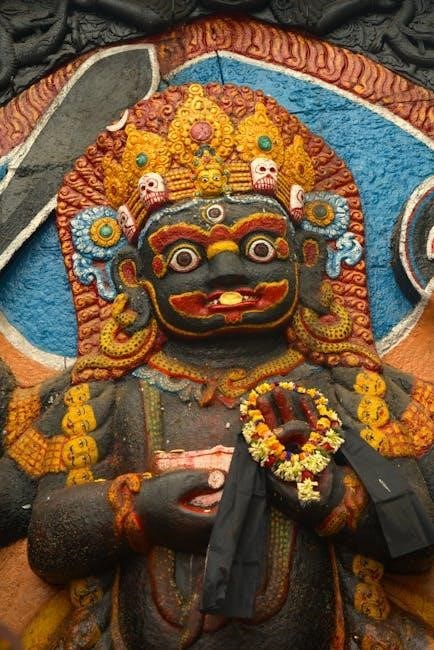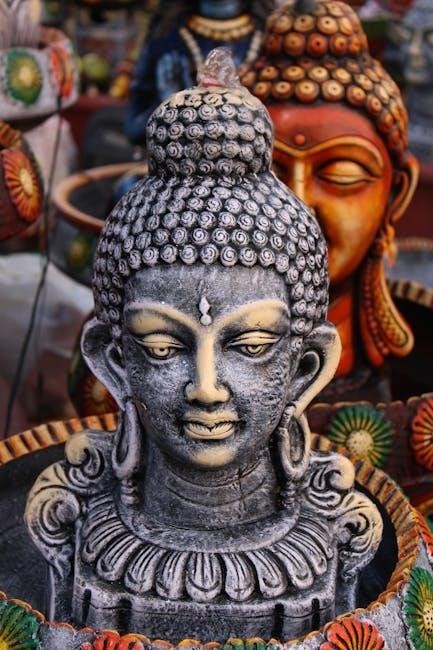The Vijñāna Bhairava Tantra is an ancient text of Kashmir Shaivism, composed around 850 CE․ It presents 162 verses in a dialogue between Shiva and Shakti, offering profound insights into consciousness, reality, and meditation․ This scripture is part of the Kaula Trika tradition and is renowned for its 112 meditation techniques, which guide seekers toward self-realization and higher states of awareness․ Its teachings emphasize the direct experience of reality, making it a cornerstone of both spiritual and philosophical studies․
1․1 Overview of the Text
The Vijñāna Bhairava Tantra is a concise yet profound Tantric text consisting of 162 verses․ It is structured as a dialogue between Bhairava (Shiva) and Bhairavī (Shakti), offering insights into the nature of consciousness and reality․ The text is a cornerstone of Kashmir Shaivism, particularly within the Trika tradition, and is celebrated for its practical teachings on meditation and self-realization․ Its 112 techniques provide a pathway to experiencing higher states of awareness․
1․2 Historical Significance and Context
The Vijñāna Bhairava Tantra, composed around 850 CE, holds a revered position in Kashmir Shaivism, particularly within the Trika tradition․ It is celebrated for its concise yet profound exploration of consciousness and meditation․ The text’s historical significance lies in its influence on scholars like Abhinavagupta, who integrated its teachings into his philosophical works․ Its enduring relevance underscores its importance as a foundational text in Tantric studies and spiritual practices․
Structure and Content of the Vijñāna Bhairava Tantra
The Vijñāna Bhairava Tantra is structured as a dialogue between Shiva and Shakti, comprising 162 verses that outline 112 meditation techniques for self-realization and spiritual growth․
2․1 Dialogue Between Shiva and Shakti
The Vijñāna Bhairava Tantra unfolds as a sacred dialogue between Shiva and Shakti, where Shiva, as Bhairava, reveals profound truths about consciousness, reality, and meditation․ Shakti, embodying the feminine principle, seeks to understand the essence of liberation and the nature of the universe․ This divine conversation serves as a guide for spiritual seekers, offering insights into the path of self-realization and the attainment of higher consciousness through practical techniques and philosophical discussions․
2․2 The 112 Meditation Techniques
The Vijñāna Bhairava Tantra presents 112 meditation techniques designed to transcend the mind and realize the true self․ These practices range from focusing on breath and sensory awareness to contemplating the nature of consciousness․ Each method is tailored to different temperaments and spiritual stages, offering a diverse path to liberation․ These techniques are practical tools for seekers aiming to experience ultimate reality and achieve spiritual awakening․

Core Concepts and Teachings
The Vijñāna Bhairava Tantra explores consciousness, reality, and liberation through direct experience․ It emphasizes the unity of existence and offers practical methods to transcend the mind and achieve self-realization․
3․1 The Nature of Consciousness and Reality
The Vijñāna Bhairava Tantra delves into the nature of consciousness and reality, presenting a monistic philosophy where consciousness is the ultimate reality․ It explores the essence of existence, emphasizing that consciousness pervades all phenomena and is the source of liberation․ The text offers a practical approach to understanding reality through direct experience, transcending duality and realizing the unity of existence․ This teaching is central to Kashmir Shaivism, guiding seekers to recognize their true nature as consciousness itself․
3․2 Dharana and Higher Consciousness
Dharana, or concentration, is a key concept in the Vijñāna Bhairava Tantra, serving as a bridge to higher consciousness․ The text emphasizes that by focusing the mind on a single point, one can transcend mental fluctuations and attain a state of awareness beyond duality․ This practice is central to realizing the unity of existence and experiencing the divine consciousness inherent in all being․ The Tantra offers practical methods to achieve this profound state;

Meditation Practices in the Vijñāna Bhairava Tantra
The text outlines 112 meditation techniques to transcend the mind, emphasizing mindfulness, breath awareness, and sensory observation․ These practices aim to reveal consciousness and achieve liberation․
4․1 Techniques for Achieving Self-Realization
The Vijñāna Bhairava Tantra offers diverse techniques for self-realization, including meditation on breath, sound, and consciousness․ These practices aim to dissolve duality, revealing the true nature of the self․ By focusing on subtle energies and higher states, practitioners transcend the mind and attain liberation․ These methods are practical and direct, suitable for seekers of all levels․
4․2 The Role of Sensory Awareness
The Vijñāna Bhairava Tantra emphasizes sensory awareness as a means to transcend ordinary perception․ By focusing on sensations, sounds, and breath, one directly experiences consciousness․ These practices help practitioners move beyond duality, achieving a unified state of awareness․ Sensory awareness is thus a powerful tool for spiritual growth and self-realization, guiding seekers to embrace the essence of their true nature․

The Role of Bhairava in the Tantra
Bhairava embodies divine consciousness and transformation, guiding Shakti through meditative practices to realize the self․ His role symbolizes the awakening and liberation of the soul․
5․1 The Concept of Bhairava
Bhairava, a fierce form of Shiva, symbolizes liberation and the destruction of fear․ He guides Shakti through meditative practices, representing the remover of ignorance and a protector of divine consciousness․ His teachings emphasize direct experience, embodying the path to self-realization in the Vijñāna Bhairava Tantra․
5․2 Bhairava as a Symbol of Transformation
Bhairava embodies the transformative power of consciousness, guiding seekers through meditation to transcend duality․ As a symbol of liberation, he represents the fearless awareness that dissolves ignorance, revealing the true self․ His teachings in the Vijñāna Bhairava Tantra offer a path to radical inner change, leading to the realization of ultimate reality and freedom from limiting perceptions;
Kashmir Shaivism and the Vijñāna Bhairava Tantra
Kashmir Shaivism, a philosophical tradition emphasizing consciousness as the ultimate reality, deeply influences the Vijñāna Bhairava Tantra․ This text is central to the Trika system, offering a practical guide to realizing consciousness through meditation and sensory awareness, as interpreted by scholars like Abhinavagupta․
6․1 The Trika School of Kashmir Shaivism
The Trika School, a cornerstone of Kashmir Shaivism, emphasizes the unity of Shiva and Shakti․ It integrates three key principles: Shiva (consciousness), Shakti (energy), and Nara (the individual)․ This philosophy underscores non-dualism, advocating for the direct experience of reality․ The Vijñāna Bhairava Tantra, a key text of Trika, offers 112 meditation techniques to realize consciousness, aligning with its teachings on spiritual liberation and self-awareness․
6․2 The Influence of Abhinavagupta
Abhinavagupta, a renowned Kashmiri scholar, profoundly influenced the interpretation of the Vijñāna Bhairava Tantra․ His work, Tantrāloka, systematized its teachings, blending philosophy and spiritual practices․ Abhinavagupta’s commentaries emphasized the unity of consciousness and the practical application of the Tantra’s meditation techniques, making its wisdom accessible for spiritual seekers and scholars alike․

Modern Relevance and Applications
The Vijñāna Bhairava Tantra’s teachings remain highly relevant today, offering practical tools for contemporary spirituality․ Its meditation techniques, focusing on consciousness and sensory awareness, are widely applied in modern yoga and personal growth practices, helping individuals cultivate inner peace and self-awareness in a fast-paced world․
7․1 The Tantra in Contemporary Spirituality
The Vijñāna Bhairava Tantra is a cornerstone in contemporary spirituality, offering timeless meditation techniques that resonate with modern seekers․ Its emphasis on direct experience and consciousness aligns with current interests in mindfulness and self-realization․ Practitioners worldwide embrace its 112 methods, finding practical applications in personal growth, stress reduction, and spiritual evolution, making it a bridge between ancient wisdom and modern life․
7․2 Practical Applications in Daily Life
The Vijñāna Bhairava Tantra offers practical meditation techniques adaptable to daily life, fostering mindfulness and emotional balance․ Its methods, such as sensory awareness and present-moment focus, help transform routine activities into meditative practices․ These tools enable individuals to cultivate inner peace, enhance productivity, and approach life challenges with clarity, making the tantra a valuable resource for modern holistic living and spiritual growth․
Accessing the Vijñāna Bhairava Tantra PDF
The Vijñāna Bhairava Tantra PDF is available through various sources, including Swami Lakshmanjoo’s manual and published translations․ These resources provide accessible versions of the ancient text․
8․1 Sources for Downloading the PDF
The Vijñāna Bhairava Tantra PDF can be downloaded from various sources, including academic platforms and spiritual websites․ Swami Lakshmanjoo’s manual, “The Manual for Self Realization,” is a trusted resource․ Additionally, digital libraries and online archives offer free and paid versions of the text, making it accessible for scholarly and personal use․ Ensure authenticity by verifying the publisher’s credibility․
8․2 Published Translations and Commentaries
Prominent translations of the Vijñāna Bhairava Tantra include works by Swami Lakshmanjoo, offering deep insights into its meditative practices․ Abhinavagupta’s commentaries in “Tantraloka” highlight its philosophical depth․ Published editions, such as “The Manual for Self Realization” and “Vijñāna Bhairava Tantra: The Ascent,” provide accessible interpretations, blending spiritual and practical perspectives for modern readers seeking enlightenment․
Key Commentaries and Interpretations
Swami Lakshmanjoo’s commentary on the Vijñāna Bhairava Tantra provides profound insights, while other scholars offer unique perspectives, enriching the understanding of this sacred text for spiritual seekers․
9․1 Swami Lakshmanjoo’s Contributions
Swami Lakshmanjoo, a revered master of Kashmir Shaivism, authored The Manual for Self Realization, a seminal work on the Vijñāna Bhairava Tantra․ His commentaries demystify the text, offering practical insights for spiritual seekers․ Lakshmanjoo’s teachings emphasize the essence of consciousness and self-realization, making the Tantra accessible to modern practitioners while preserving its timeless wisdom․
9․2 Other Prominent Scholars and Their Insights
Prominent scholars like Abhinavagupta and Swami Satsangananda Saraswati have significantly contributed to the understanding of the Vijñāna Bhairava Tantra․ Abhinavagupta’s works, such as Tantraloka, provide deep philosophical insights, while Swami Satsangananda’s commentaries offer practical interpretations․ Their contributions bridge ancient wisdom with modern applicability, enriching the text’s relevance for contemporary spiritual seekers and scholars alike․

Comparative Analysis with Other Tantric Texts
The Vijñāna Bhairava Tantra, part of Kashmir Shaivism, shares similarities with the Bhairava Agama but is distinct in its concise focus on 112 meditation techniques․ Its unique approach to consciousness and liberation sets it apart from other Shaiva texts, offering a practical yet profound path to self-realization․
10․1 Similarities with the Bhairava Agama
The Vijñāna Bhairava Tantra and the Bhairava Agama share roots in Kashmir Shaivism, both outlining nine methods for entering higher consciousness․ While the VBT is known for its concise presentation of 112 practical techniques, the Bhairava Agama elaborates on ritual and philosophical frameworks․ Both texts emphasize direct experience and the unity of consciousness, making them complementary resources for spiritual exploration and self-realization․
10․2 Distinctions from Other Shaiva Texts
The Vijñāna Bhairava Tantra stands out for its focus on direct experience and consciousness, unlike other Shaiva texts that often emphasize ritual or dualistic philosophies․ Its concise structure and 112 practical meditation techniques make it unique, offering a non-dualistic approach to self-realization․ While other texts may delve into complex rituals, the VBT prioritizes inner awareness, setting it apart as a accessible guide for spiritual seekers․

The Role of the Vijñāna Bhairava Tantra in Yoga
The Vijñāna Bhairava Tantra provides 112 meditation techniques, integrating consciousness and reality, influencing modern yoga by offering practical methods for self-realization and higher awareness in contemporary practices․
11․1 Integration into Yogic Practices
The Vijñāna Bhairava Tantra offers 112 meditation techniques that seamlessly integrate into yogic practices, emphasizing sensory awareness and concentration (dharana)․ These methods, rooted in Kashmir Shaivism, guide practitioners to merge consciousness with reality, fostering self-realization․ The text’s practical approaches align with yoga’s goal of uniting the individual self with the universal, making it a valuable resource for contemporary yogic disciplines and spiritual growth․
11․2 Its Influence on Modern Yoga Traditions
The Vijñāna Bhairava Tantra’s 112 meditation techniques have significantly influenced modern yoga, offering practical methods for achieving higher consciousness․ Its emphasis on sensory awareness and concentration aligns with contemporary yoga’s focus on mindfulness and holistic well-being; Teachers and practitioners worldwide incorporate these techniques to deepen meditation and self-realization, making the Tantra a timeless resource for enhancing yogic practices and spiritual growth in the modern era․
The Vijñāna Bhairava Tantra is a timeless guide to consciousness and self-realization, offering universal wisdom that transcends eras․ Its practical techniques and profound insights continue to inspire spiritual seekers, making it a cornerstone of both ancient and modern spiritual traditions․ This text remains a vital resource for those seeking liberation and higher consciousness․
12․1 The Enduring Legacy of the Tantra
The Vijñāna Bhairava Tantra, an 8th-century text, has left an indelible mark on spiritual traditions․ Its 162 verses, rooted in Kashmir Shaivism, continue to inspire modern seekers․ The tantra’s 112 meditation techniques, emphasizing consciousness and reality, remain timeless․ Scholars like Swami Lakshmanjoo have further illuminated its teachings, ensuring its relevance in contemporary spirituality․ Its legacy endures as a profound guide for self-realization and higher consciousness․
12․2 Encouragement for Further Study
The Vijñāna Bhairava Tantra offers profound insights into consciousness and meditation, making it a valuable text for spiritual seekers․ Readers are encouraged to explore its teachings through available PDF resources and commentaries by scholars like Swami Lakshmanjoo․ Delving deeper into its 112 meditation techniques and philosophical framework can enrich one’s understanding of Kashmir Shaivism and its practical applications in modern life․
